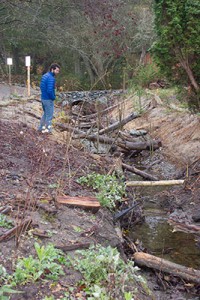
Source: Northwest Indian Fishieries Commission
The Tulalip Tribes recently improved rearing habitat in a small coastal stream popular with juvenile chinook.
Known to locals as “the gulch,” the unnamed stream had one of the highest densities of juvenile chinook of all the coastal streams sampled in the Whidbey basin by the Tulalip Tribes and Skagit River System Cooperative. During one electrofishing survey, natural resources staff found 280 chinook among a total of 600 juvenile salmon that also included coho and other species.
“They can live there for many weeks, so it’s more than just acclimating,” said Derek Marks, Timber Fish and Wildlife manager for Tulalip. “They’re actually rearing and growing in there.”
Despite those numbers, the tribes saw room for improvement. At the time, the gulch was little more than a ditch overgrown with invasive plants. Old county stormwater assessments referred to it as Greenwood Creek, probably named for a nearby grange.
A degraded culvert partially impeded fish passage upstream. “The culvert was rusting and on its way out,” said Tulalip biologist Brett Shattuck, project manager for what became the Greenwood Creek Stream Enhancement Project. “The stream was lined with rocks that created more of a flume than a channel.”
Greenwood Creek is county-owned and in a public right-of-way. The tribes and Snohomish County worked with Adopt-a-Stream to replace the culvert, clear the invasives and realign about 250 feet of habitat.
Interpretive signs are planned to help the public understand the importance of small coastal streams to migrating salmon. Before the restoration, people may not have realized that the small drainage ditch was being used by juvenile salmon.
“We want to show people how successful restoration can be in coastal streams, and to raise awareness that these streams have value for fish,” Shattuck said. “We monitored fish use for three years before the project and will continue to monitor it for several years after construction.”
